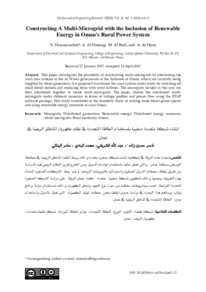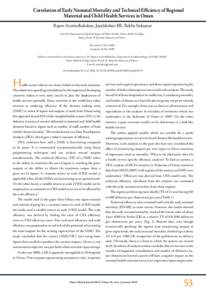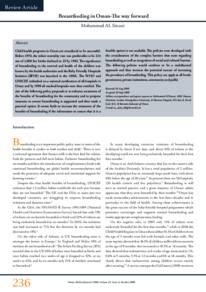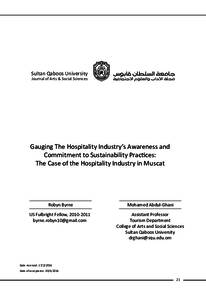Document
Impact of the domestic labor market on sustainability of agriculture in Oman.
Contributors
Al Farsiyah, Hanam., Author
Publisher
جامعة السلطان قابوس. كلية العلوم الزراعية والبحرية
Gregorian
2018
Language
English
English abstract
In 2013, only 16% of households in Oman have reported agriculture as the main occupation and 53% have reported non-agricultural government employment as the main occupation, whilst the balance is employed in the private and non-formal sectors. This situation is hypothesized to be related to the labor market; where government legislated higher remuneration in the non-agricultural government sector vis-a-vis agricultural sector, influences Omani farmers to move to non-agricultural employment, causing reduced cultivated area and farm production. The study uses operations research methods to quantify the impact of labor market policies on agricultural employment, farm gross income and land use intensity. In an national average farm of 0.9 ha with 1.33 persons of family labor available, only 75% land use intensity is achieved, with a gross income of 1061 OMR/Year/Household, which is below legislated minimum income for low skilled employment in the non-agricultural government sector (4632 OMR/Year/Household). The household gross income would increase to 5304 OMR/Year/Household with non-agricultural employment of 1 person and 0.33 persons in agricultural employment, which explains low employment of Omani's in agriculture. Farms of 2.1 ha (5 Feddans), with availability of 1.33 family labor earns a gross return of 2502 OMR/Year/Household, which is again less than the salary in the non-agricultural government sector. However, with the current government policy of allowing to hire 1 expatriate laborer per 2.1 ha with 1 Omani person in non-agricultural employment and 0.33 family labor in agricultural employment, gross income increases to 6414 OMR/Year/Household and further if temporary labor hiring is allowed at peak farm labor requirements, gross income could be increased to 6632 OMR/Year/Household. The current policy on hiring 1 expatriate labor per 2.1 ha along with non-agricultural employment of Omani labor is in the short-run optimal.
Member of
ISSN
2410-1079
Resource URL
Citation
Kotagama, H., & Al Farsiyah, H. (2018). Impact of the domestic labor market on sustainability of agriculture in Oman. Agricultural and Marian Sciences Journal, 23 (1), 24-28.
Arabic abstract
في عام 2013، تم الإشارة إلى أن 16% فقط من الأسر في سلطنة عُمان تعمل في الزراعة باعتبارها المهنة الرئيسية و53% أفادوا بأن الوظائف الحكومية غير الزراعية هي المهنة الرئيسية لهم، في حين يعمل البقية في القطاعين الخاص وغير الرسمي. ويفترض أن تكون هذه الحالة مرتبطة بسوق العمل؛ حيث قامت الحكومة بتشريع أجور أعلى في القطاع الحكومي غير الزراعي مقابل القطاع الزراعي، مما دفع المزارعين العمانيين للانتقال إلى الوظائف غير الزراعية، وهذا بدوره سبب انخفاض المساحة المزروعة والإنتاج الزراعي. تستخدم الدراسة أساليب أبحاث العمليات لتحديد تأثير سياسات سوق العمل على العمالة الزراعية، والدخل الإجمالي للمزرعة وكثافة استخدام الأراضي. في المزرعة الوطنية البالغة 0.9 هكتار مع 1.33 شخص من العمالة العائلية المتاحة، لا يتم تحقيق سوى 75% من استخدام الأرض، مع دخل إجمالي يبلغ 1061 ريال عماني لكل سنة، وهو أقل من الحد الأدنى من الدخل القانوني للعاملين بالوظائف التي تتطلب مهارات منخفضة في القطاع الحكومي غير الزراعي (4632 ريال عماني لكل سنة). وسيزيد الدخل الإجمالي للأسر إلى 5304 ريال عماني في السنة بوجود شخص يعمل في الوظائف غير الزراعية و0.33 شخص في العمالة الزراعية، مما يفسر انخفاض العمالة العمانية في الزراعة. . المزارع التي تبلغ 2.1 هكتار (5 فدان)، مع توفر 1.33 من عمالة الأسرة، تبلغ إجمالي العائدات 2502 ريال عماني لكل سنة، وهو أقل مرة أخرى من الراتب في القطاع الحكومي غير الزراعي. ومع ذلك، مع السياسة الحكومية الحالية المتمثلة في السماح بتعيين عامل وافد واحد لكل 2.1 هكتار مع شخص عماني واحد في العمالة غير الزراعية و0.33 من العمالة العائلية في العمالة الزراعية، يرتفع إجمالي الدخل إلى 6414 ريال عماني لكل سنة، وأكثر من ذلك إذا تم السماح بتوظيف العمالة المؤقتة في أوقات ذروة متطلبات العمل الزراعي ، حيث أن إجمالي الدخل سيزيد إلى 6632 ريال عماني في السنة . إن السياسة الحالية بشأن توظيف العمالة الوافدة لكل 2.1 هكتار إلى جانب التوظيف غير الزراعي للعمالة العمانية يعتبر في المدى القصير هو الأمثل.
Category
Journal articles







